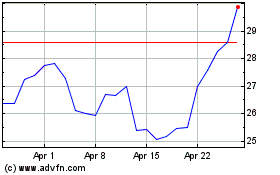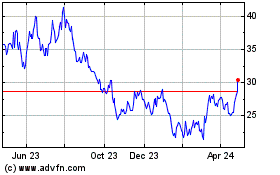U.S. Stock Futures Point to Lower Opening After Jobs Report
March 08 2019 - 9:49AM
Dow Jones News
By Will Horner and Shen Hong
U.S. stock futures extended declines, setting major indexes up
for their worst week since December, after data showed hiring
growth slowed significantly in February.
S&P 500 futures were down 0.9% in recent trading, compared
with a 0.5% decline ahead of the latest jobs report from the Labor
Department. Changes in futures don't necessarily reflect moves
after the opening bell.
Friday's data showed U.S. nonfarm payrolls rose a seasonally
adjusted 20,000 in February, missing economists' expectations of
180,000 new jobs and reigniting concerns around the health of the
U.S. economy.
Still, the report wasn't all gloomy. The unemployment rate
ticked down to 3.8% from 4% a month earlier, while wages rose 3.4%
from a year earlier -- the strongest pace since April 2009. The
mixed data likely helped protect stocks against steeper losses,
analysts said, adding that there was some question whether the
government shutdown or a recent major snowstorm contributed to the
weaker-than-expected jobs print.
"You can say this is not consistent with what we've seen from
earnings," said Tony Roth, chief investment officer at Wilmington
Trust.
Major U.S. indexes have been pummeled this week by concerns of
weakening economic growth in Europe and Asia, on top of worries
that a trade deal between the U.S. and China isn't imminent.
Downbeat data from China overnight added to the sense of gloom.
A report Friday showed Chinese exports slid 20.7% in February
from a year earlier -- a much steeper decline than economists had
expected. Imports tumbled 5.2%, also a bigger drop than
expected.
The data pushed shares of Chinese companies lower, with major
indexes suffering their worst day since October. The Shanghai
Composite Index fell 4.4% and its smaller Shenzhen counterpart
dropped 3.8%, their biggest single-day drops in five months.
Elsewhere in the region, Japan's Nikkei Stock Average closed 2%
lower, while South Korea's Kospi lost 1.3%.
Meanwhile, in Europe, plans by the European Central Bank to
deploy additional stimulus helped trigger losses overnight in U.S.
and European stocks, since they suggested policy makers had become
increasingly concerned about the slowdown across the region.
The ECB said Thursday it would hold interest rates months longer
than initially signaled -- at least until the end of 2019 -- and
issued a new batch of cheap long-term loans to banks starting in
September. The central bank also slashed its forecast for gross
domestic product growth for 2019 to 1.1% from 1.7% in December and
cut its inflation projections.
Despite the concerned response from markets, some welcomed the
actions taken by ECB President Mario Draghi as necessary to guard
against a worsening of the global slowdown.
"It seems like Draghi, at least, wanted to be seen as decisive.
Now is better to act, sooner, pre-emptive, rather than later," said
Geoffrey Yu, head of the U.K. investment office of UBS Wealth
Management.
While the ECB's moves showed they were concerned about the
slowdown, their actions should be read as vigilance, rather than
anxiety, he added. "They are erring on the side of caution."
Jim Reid, an analyst at Deutsche Bank, said in a note that
markets interpreted the ECB's stimulus measures as "nowhere near
substantial enough," considering the downward revisions of growth
forecasts.
Investors in Europe were eyeing poor data from Germany that
showed the nation's manufacturing orders plunged 2.6% in January
from December, missing economists' forecasts of 0.5%.
Wall Street closed lower Thursday as growth worries and
lingering questions over the U.S.-China trade dispute weighed on
sentiment. The Dow and S&P 500 both closed down 0.8%.
European investors were taking the cocktail of bad news as a cue
to move back into the safety of government bonds, as the yield on
German bunds fell to 0.058%. The yield on the U.S. benchmark
10-year Treasury note inched up to 2.638% Friday from 2.637% late
Thursday, according to Tradeweb. Yields move inversely to
prices.
Michael Wursthorn contributed to this article.
Write to Shen Hong at hong.shen@wsj.com
(END) Dow Jones Newswires
March 08, 2019 09:34 ET (14:34 GMT)
Copyright (c) 2019 Dow Jones & Company, Inc.
JD com (NASDAQ:JD)
Historical Stock Chart
From Mar 2024 to Apr 2024

JD com (NASDAQ:JD)
Historical Stock Chart
From Apr 2023 to Apr 2024
